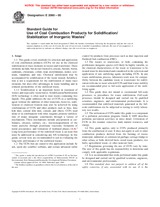Wir benötigen Ihre Einwilligung zur Verwendung der einzelnen Daten, damit Sie unter anderem Informationen zu Ihren Interessen einsehen können. Klicken Sie auf "OK", um Ihre Zustimmung zu erteilen.
ASTM E2060-00
Standard Guide for Use of Coal Combustion Products for Solidification/Stabilization of Inorganic Wastes
Automatische name übersetzung:
Standard-Leitfaden für den Einsatz von Kraftwerksnebenprodukte für die Verfestigung / Stabilisierung anorganischer Abfälle
NORM herausgegeben am 10.2.2000
Informationen über die Norm:
Bezeichnung normen: ASTM E2060-00
Anmerkung: UNGÜLTIG
Ausgabedatum normen: 10.2.2000
SKU: NS-44140
Zahl der Seiten: 7
Gewicht ca.: 21 g (0.05 Pfund)
Land: Amerikanische technische Norm
Kategorie: Technische Normen ASTM
Die Annotation des Normtextes ASTM E2060-00 :
Keywords:
ICS Number Code 13.030.40 (Installations and equipment for waste disposal and treatment)
Ergänzende Informationen
| 1. Scope | ||||||||||||||||||||||||||||||||||||||||||||||||
|
1.1 This guide covers methods for selection and application of coal combustion products (CCPs) for use in the chemical stabilization of trace elements in wastes and wastewater. These elements include, but are not limited to, arsenic, barium, boron, cadmium, chromium, cobalt, lead, molybdenum, nickel, selenium, vanadium, and zinc. Chemical stabilization may be accompanied by solidification of the waste treated. Solidification is not a requirement for the stabilization of many trace elements, but does offer advantages in waste handling and in reduced permeability of the stabilized waste. 1.1.1 Solidification is an important factor in treatment of wastes and especially wastewaters. Solidification/Stabilization (S/S) technology is often used to treat wastes containing free liquids. This guide addresses the use of CCPs as a stabilizing agent without the addition of other materials; however, stabilization or chemical fixation may also be achieved by using combinations of CCPs and other products such as lime, lime kiln dust, cement kiln dust, cement, and others. CCPs used alone or in combination with other reagents promote stabilization of many inorganic constituents through a variety of mechanisms. These mechanisms include precipitation as carbonates, silicates, sulfates, etc.; microencapsulation of the waste particles through pozzolanic reactions; formation of metal precipitates; and formation of hydrated phases (). Long-term performance of the stabilized waste is an issue that must be addressed in considering any S/S technology. In this guide, several tests are recommended to aid in evaluating the long-term performance of the stabilized wastes. 1.2 The CCPs that are suited to this application include fly ash, spent dry scrubber sorbents, and certain advanced sulfur control by-products from processes such as duct injection and fluidized-bed combustion (FBC). 1.3 The wastes or wastewater, or both, containing the problematic inorganic species will likely be highly variable, so the chemical characteristics of the waste or wastewater to be treated must be determined and considered in the selection and application of any stabilizing agent, including CCPs. In any waste stabilization process, laboratory-scale tests for compatibility between the candidate waste or wastewater for stabilization with one or more selected CCPs and final waste stability are recommended prior to full-scale application of the stabilizing agent. 1.4 This guide does not intend to recommend full-scale processes or procedures for waste stabilization. Full-scale processes should be designed and carried out by qualified scientists, engineers, and environmental professionals. It is recommended that stabilized materials generated at the full-scale stabilization site be subjected to testing to verify laboratory test results. 1.5 The utilization of CCPs under this guide is a component of a pollution prevention program; Guide E 1609 describes pollution prevention activities in more detail. Utilization of CCPs in this manner conserves land, natural resources, and energy. 1.6 This guide applies only to CCPs produced primarily from the combustion of coal. It does not apply to ash or other combustion products derived from the burning of waste; municipal, industrial, or commercial garbage; sewage sludge or other refuse, or both; derived fuels; wood waste products; rice hulls; agricultural waste; or other noncoal fuels. 1.7 Regulations governing the use of CCPs vary by state. The user of this guide has the responsibility to determine and comply with applicable regulations. 1.8 It is recommended that work performed under this guide be designed and carried out by qualified scientists, engineers, and environmental professionals. This standard does not purport to address all of the safety concerns, if any, associated with its use. It is the responsibility of the user of this standard to establish appropriate safety and health practices and determine the applicability of regulatory limitations prior to use. |
||||||||||||||||||||||||||||||||||||||||||||||||
| 2. Referenced Documents | ||||||||||||||||||||||||||||||||||||||||||||||||
|
Empfehlungen:
Aktualisierung der technischen Normen
Wollen Sie sich sicher sein, dass Sie nur die gültigen technischen Normen verwenden?
Wir bieten Ihnen eine Lösung, die Ihnen eine Monatsübersicht über die Aktualität der von Ihnen angewandten Normen sicher stellt.
Brauchen Sie mehr Informationen? Sehen Sie sich diese Seite an.




 Cookies
Cookies
